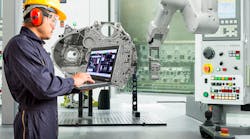Successful modern manufacturing means making the most of cutting-edge technologies. One advance that has reshaped manufacturing practices is the incorporation of data analytics.
Data analytics unlocks manufacturing facilities' potential by providing real-time insights, facilitating data-informed decision-making, and increasing efficiency and productivity. Here are some ways that data analytics can help manufacturers build a more profitable and successful business.
Historically, decision-making in manufacturing plants relied heavily on methods and intuition. With data analytics, manufacturers can now use the power of information generated by technological systems and sensors across their operations. Manufacturing analytics relies on machine data and operational processes to improve performance, enhance productivity, optimize decision-making, and ensure product quality.
The power of analytics
By accessing and analyzing this data, manufacturers gain critical information about every sector of their manufacturing processes.
Real-time insights. Real-time manufacturing analytics involves gathering and analyzing data from production processes and equipment. Data analytics empowers manufacturers to monitor operations, enabling thoughtful decision-making rather than reactive responses to challenges. Manufacturers can identify anomalies, predict equipment failures, and optimize production schedules to enhance efficiency by collecting and analyzing data from sensors embedded in machinery.
For example, by analyzing machines’ key performance metrics manufacturers can identify patterns that indicate maintenance issues before they escalate into significant downtime. With this information, manufacturers can plan maintenance tasks during production pauses, allowing the company to lower maintenance costs and avoid disruptions to production schedules.
Supply chain transparency and reliability are other benefits of real-time analytical insights in the manufacturing industry. These two factors are critical to obtaining and keeping customer loyalty in a manufacturing brand.
Additionally, real-time analytics encourages better environmental safety processes and standards. Manufacturers can immediately determine and mitigate risks to the plant and its employees by continuously monitoring equipment conditions and emissions levels.
Predictive maintenance. A critical advantage of using data analytics in manufacturing is the benefits of predictive maintenance. This condition-based monitoring system uses real-time device diagnostics to locate and diagnose mechanical failures using machine sensors and robots with Internet of Things (IoT) technology.
A successful manufacturing company depends on the reliability of its equipment and machinery. If malfunctions or failures occur, it can lead to these harmful results:
- Increased costs;
- Increased liability;
- Substandard end products;
- Reputational and brand damage.
Typically, data for predictive maintenance is collected by infrared analysis, acoustic monitoring, and vibration analysis, which consider performance variables such as usage patterns and equipment age. The benefits of predictive maintenance are widespread, including:
- Increased productivity;
- Reduced downtime;
- Equipment reliability;
- Lower maintenance costs;
- Reduced risk;
- Increased equipment lifespan;
- Increased overall equipment effectiveness.
For example, a manufacturer may use infrared analysis to check temperatures of heating, ventilation, and air-conditioning systems. Then, managers can use data analytics to create the best maintenance schedule based on their equipment. Anticipatory maintenance is also helpful for quality control purposes. This process can identify product defects before they leave the production line, saving the business money and preventing risk and reputational damage.
Automation through predictive maintenance systems also helps to reduce human errors in manufacturing. When employees interact with high-speed production processes, hazardous materials, and complex machinery and equipment, those operations are more prone to human mistakes or misjudgments.
Additionally, employees who are burnt out from work may experience adverse mental health outcomes, such as depression. In turn, those employees are 20% more likely to make physical errors on the job, which can be dangerous in manufacturing settings. By automating many procedures and determining when part of the production line or machinery is more likely to cause potential harm, employee mistakes and possible injuries can be avoided.
Optimized processes. Data analysis is also an ideal tool for optimizing manufacturing processes. It allows manufacturers to examine information from production lines, sensors, supply chains, and inventory management systems. This makes it easier to locate bottlenecks that slow production and resolve them, improving production efficiency.
Production efficiency involves multiple activities meant to increase production. Aside from providing the same benefits as predictive maintenance, production optimization minimizes waste and reduces unnecessary steps, increasing profitability through cost reduction. Many manufacturers struggle to minimize supply chain waste, such as overproduction, overstock, and inefficient resource usage.
Optimizing production processes with data and KPIs helps manufacturers find and eliminate waste sources, resulting in cost savings. Manufacturers no longer deal with excessive costs caused by unnecessary packaging, spoilage, and extra transportation. Data analytics and KPIs help reduce supply chain waste and encourage manufacturers to design a more efficient logistics system.
Optimizing production processes lets manufacturers adapt rapidly to market changes and stay ahead of the curve in their respective industries. Market trends and consumer demands are constantly in flux, and with efficient processes in place, manufacturers can respond quickly to changes while remaining competitive.
Overcoming challenges. Adopting a data-informed approach requires careful consideration and planning. A common difficulty for beginners involves integrating data, as many plants have separate data sources and systems that need to be merged to enable accurate and comprehensive data analysis.
Another challenge manufacturers face when they start data analysis is data quality. Inaccurate or poor data can lead to unreliable predictions and insights, undermining the benefits of analytics. Manufacturers must invest in high-quality data management to ensure the information they assess is accurate and complete.
Employees’ buy-in is another potential challenge. Education and training programs can ease their uncertainty about moving away from more traditional working methods, but employees must understand the benefits of data analytics and how it can assist them in their work processes.
The Future of Manufacturing
As information and manufacturing technologies advance, the importance of data analytics will accelerate, leading to better operational efficiencies and greater business insights. Upcoming technological trends in manufacturing will likely impact this sector soon, particularly in the following ways.
IIoT implementation. According to Oracle, 50% of manufacturers will use the IIoT by 2025. The IIoT will use location data to monitor and track products within the supply chain, and provide even more sensitive and accurate sensors to monitor changes in humidity, vibration frequencies, and temperature in manufacturing equipment, alert users to the need for software fixes, or indicate when potential equipment failure may occur.
Digital transformation tools. Many manufacturers will accelerate their use of digital tools by implementing artificial intelligence (AI) tools, robotics, data lakes, and the latest connectivity standards. The data gathered with the assistance of these digital tools will allow manufacturers in any industry to leverage information to create new, more productive business models with less overhead and more efficient operations.
Edge computing. Edge computing processes data processing near its source, minimizing delays and allowing real-time decision-making without relying on cloud-based systems. This tool is highly beneficial for manufacturing facilities where swift responsiveness is vital, such as predictive maintenance or quality assurance.
Data analytics offers the potential to transform the productivity and efficiency of manufacturing facilities by delivering real-time information for informed decision-making purposes. That data enables predictive maintenance and optimized production processes. Manufacturers can make better-informed decisions and increase productivity by gathering this critical data through the manufacturing process.
Although implementing a data-driven approach poses challenges, the benefits outweigh the potential obstacles. The role of data analytics in manufacturing will grow even more significant as manufacturers work toward processes that are safer, more efficient, and more profitable. Embracing data analytics is necessary for manufacturers to thrive in a digital era.
Ainsley Lawrence is a freelance writer and editor.








